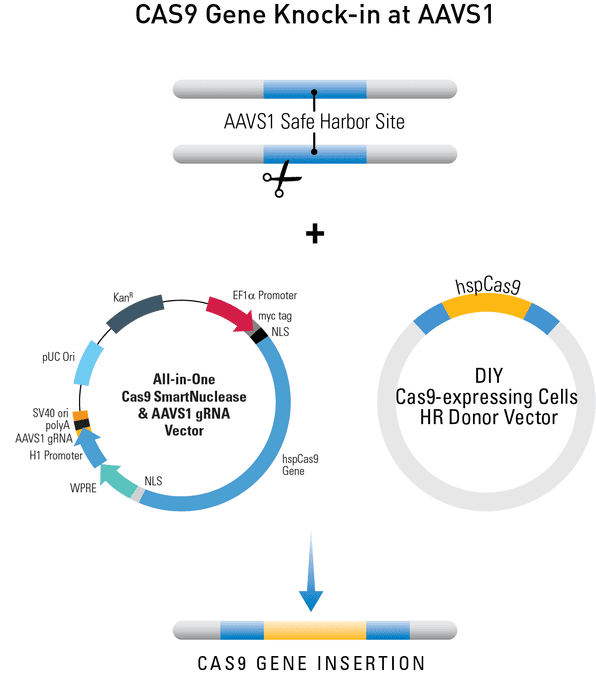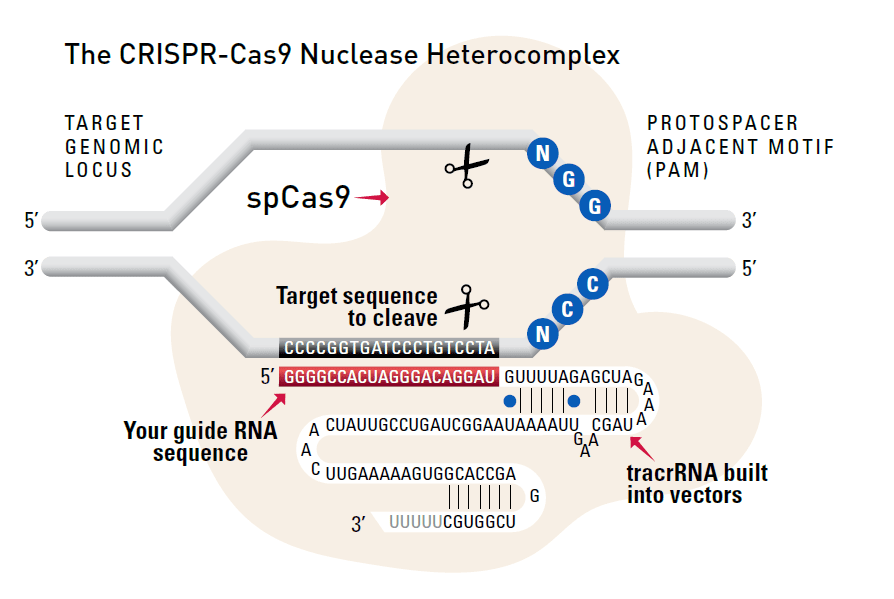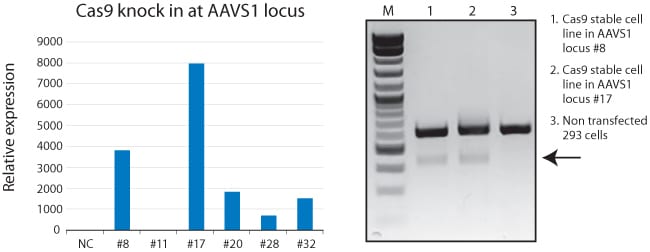DIY Cas9-expressing Cells HR Donor
Products
| Catalog Number | Description | Size | Price | Quantity | Add to Cart | |||
|---|---|---|---|---|---|---|---|---|
| CAS620A-1 | HR Donor Vector to knock-in Cas9 to the AAVS1 Safe Harbor Site (AAVS1-SA-puro-EF1α-hspCas9) | 10 µg | $1638 |
|
||||
Overview
Overview
Streamline genome-wide surveys and screens
With cell lines that express Cas9, you can more easily and efficiently conduct high-throughput gRNA validation and genome-wide surveys and screens. SBI’s DIY Cas9-expressing Cells HR Donor enables the knock-in of hspCas9 into the AAVS1 safe harbor site so that you can stably express Cas9 in the cell line of your choice.

Use with any Cas9 delivery method and a gRNA targeting AAVS1 (we recommend our All-in-one Cas9 SmartNuclease & AAVS1 gRNA Plasmid). As with all of our AAVS1 HR Targeting Vectors, the DIY Cas9-expressing Cells HR Donor is designed to limit off-target integration. Taking advantage of the AAVS1's location within an intron, these vectors come with a puromycin marker that has no promoter, only a splice acceptor site—expression of puromycin can only occur when the construct integrates within an intron, reducing the probability of recovering off-target integrants in the presence of puromycin selection.
References
How It Works
How It Works
Make your own Cas9-expressing cells
Making your own Cas9-expressing cells follows the same workflow as a gene knock-in (Figure 1)—co-transfect the HR Donor vector with a Cas9 delivery method and a gRNA targeting AAVS1 (we recommend our All-in-one Cas9 SmartNuclease & AAVS1 gRNA Plasmid). The gRNA targeting AAVS1 will direct Cas9 activity to the AAVS1 site resulting in a double-strand break (DSB). Because the donor arms on the DIY Cas9-expressing Cells HR Donor are complementary to the AAVS1 site, they will mediate repair of the DSB through homologous recombination of the donor arms with the AAVS1 site. Repair with the HR Donor will result in the hspCas9 gene being inserted into the AAVS1 site.
Figure 1. Schematic showing CRISPR/Cas9-mediated gene knock-in of Cas9 at the AAVS1 safe harbor site.
CRISPR/Cas9 Basics
Through careful selection of the target sequence and design of a donor plasmid for homologous recombination, you can achieve efficient and highly targeted genomic modification with CRISPR/Cas9.
Cas9 protein—uses guide RNA (gRNA) to direct site-specific, double-strand DNA cleavage adjacent to a protospacer adapter motif (PAM) in the target DNA.
gRNA—RNA sequence that guides Cas9 to cleave a homologous region in the target genome. Efficient cleavage only where the gRNA homology is adjacent to a PAM.
PAM—protospacer adapter motif, NGG, is a target DNA sequence that spCas9 will cut upstream from if directed to by the gRNA.
The workflow at-a-glance
DESIGN: Select gRNA and HR donor plasmids. Choice of gRNA site and design of donor plasmid determines whether the homologous recombination event results in a knock-out, knock-in, edit, or tagging.
CONSTRUCT: Clone gRNA into all-in-one Cas9 vector. Clone 5’ and 3’ homology arms into HR donor plasmid. If creating a knock-in, clone desired gene into HR donor.
CO-TRANSFECT or CO-INJECT: Introduce Cas9, gRNA, and HR Donors into the target cells using co-transfection for plasmids, co-transduction for lentivirus, or co-injection for mRNAs.
SELECT/SCREEN: Select or screen for mutants and verify.
VALIDATE: Genotype or sequence putative mutants to verify single or biallelic conversion.
Supporting Data
Supporting Data
Get good Cas9 expression from the AAVS1 site
Cas9-knock-in-data
Figure 2. Use of the DIY Cas9-expressing Cells HR Donor leads to good expression of Cas9 from the AAVS1 site. We knocked the CAS9 gene into the AAVS1 site using the DIY Cas9-expressing Cells HR Donor and the All-in-one Cas9 SmartNuclease & AAVS1 gRNA Plasmid. We then tested the resulting positive clones for relative Cas9 mRNA expression using qPCR (left panel) and analyzed the two highest-expressing clones (#8 and 17) for Cas9-mediated cleavage activity using a Surveyor Assay (right panel, arrow indicated band showing Cas9-mediated cleavage). In the Surveyor Assay, only the two lanes with the Cas9 clones showed Cas9 activity (arrow), with the non-transfected cells showing no Cas9 activity.
FAQs
Documentation
Citations
Related Products
Products
| Catalog Number | Description | Size | Price | Quantity | Add to Cart | |||
|---|---|---|---|---|---|---|---|---|
| CAS620A-1 | HR Donor Vector to knock-in Cas9 to the AAVS1 Safe Harbor Site (AAVS1-SA-puro-EF1α-hspCas9) | 10 µg | $1638 |
|
||||
Overview
Overview
Streamline genome-wide surveys and screens
With cell lines that express Cas9, you can more easily and efficiently conduct high-throughput gRNA validation and genome-wide surveys and screens. SBI’s DIY Cas9-expressing Cells HR Donor enables the knock-in of hspCas9 into the AAVS1 safe harbor site so that you can stably express Cas9 in the cell line of your choice.

Use with any Cas9 delivery method and a gRNA targeting AAVS1 (we recommend our All-in-one Cas9 SmartNuclease & AAVS1 gRNA Plasmid). As with all of our AAVS1 HR Targeting Vectors, the DIY Cas9-expressing Cells HR Donor is designed to limit off-target integration. Taking advantage of the AAVS1's location within an intron, these vectors come with a puromycin marker that has no promoter, only a splice acceptor site—expression of puromycin can only occur when the construct integrates within an intron, reducing the probability of recovering off-target integrants in the presence of puromycin selection.
References
How It Works
How It Works
Make your own Cas9-expressing cells
Making your own Cas9-expressing cells follows the same workflow as a gene knock-in (Figure 1)—co-transfect the HR Donor vector with a Cas9 delivery method and a gRNA targeting AAVS1 (we recommend our All-in-one Cas9 SmartNuclease & AAVS1 gRNA Plasmid). The gRNA targeting AAVS1 will direct Cas9 activity to the AAVS1 site resulting in a double-strand break (DSB). Because the donor arms on the DIY Cas9-expressing Cells HR Donor are complementary to the AAVS1 site, they will mediate repair of the DSB through homologous recombination of the donor arms with the AAVS1 site. Repair with the HR Donor will result in the hspCas9 gene being inserted into the AAVS1 site.
Figure 1. Schematic showing CRISPR/Cas9-mediated gene knock-in of Cas9 at the AAVS1 safe harbor site.
CRISPR/Cas9 Basics
Through careful selection of the target sequence and design of a donor plasmid for homologous recombination, you can achieve efficient and highly targeted genomic modification with CRISPR/Cas9.
Cas9 protein—uses guide RNA (gRNA) to direct site-specific, double-strand DNA cleavage adjacent to a protospacer adapter motif (PAM) in the target DNA.
gRNA—RNA sequence that guides Cas9 to cleave a homologous region in the target genome. Efficient cleavage only where the gRNA homology is adjacent to a PAM.
PAM—protospacer adapter motif, NGG, is a target DNA sequence that spCas9 will cut upstream from if directed to by the gRNA.
The workflow at-a-glance
DESIGN: Select gRNA and HR donor plasmids. Choice of gRNA site and design of donor plasmid determines whether the homologous recombination event results in a knock-out, knock-in, edit, or tagging.
CONSTRUCT: Clone gRNA into all-in-one Cas9 vector. Clone 5’ and 3’ homology arms into HR donor plasmid. If creating a knock-in, clone desired gene into HR donor.
CO-TRANSFECT or CO-INJECT: Introduce Cas9, gRNA, and HR Donors into the target cells using co-transfection for plasmids, co-transduction for lentivirus, or co-injection for mRNAs.
SELECT/SCREEN: Select or screen for mutants and verify.
VALIDATE: Genotype or sequence putative mutants to verify single or biallelic conversion.
Supporting Data
Supporting Data
Get good Cas9 expression from the AAVS1 site
Cas9-knock-in-data
Figure 2. Use of the DIY Cas9-expressing Cells HR Donor leads to good expression of Cas9 from the AAVS1 site. We knocked the CAS9 gene into the AAVS1 site using the DIY Cas9-expressing Cells HR Donor and the All-in-one Cas9 SmartNuclease & AAVS1 gRNA Plasmid. We then tested the resulting positive clones for relative Cas9 mRNA expression using qPCR (left panel) and analyzed the two highest-expressing clones (#8 and 17) for Cas9-mediated cleavage activity using a Surveyor Assay (right panel, arrow indicated band showing Cas9-mediated cleavage). In the Surveyor Assay, only the two lanes with the Cas9 clones showed Cas9 activity (arrow), with the non-transfected cells showing no Cas9 activity.




